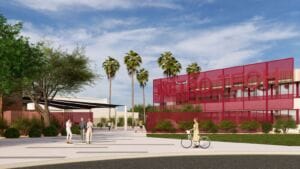Home prices continue their upward climb in the Phoenix area, with more momentum expected until at least June. A new report from the W. P. Carey School of Business at Arizona State University reveals the latest information about the Maricopa and Pinal County housing market, as of March:
The median single-family home price was all the way up to $175,000, about a 30-percent increase from March of last year.
The supply of homes for sale continued to fall, but the problem is not so much the high demand, but more the lack of sellers getting into the market.
Rebounding population growth in the Phoenix area is also blasting past the rate at which builders are constructing new homes.
Phoenix-area home prices reached a low in September 2011 and have largely shot up since then. The median single-family home price went up 29.7 percent – from $134,900 to $175,000 – in the year from March 2012 to March 2013. Realtors will note the average price per square foot went up 23.6 percent during the same time. The median townhouse/condo price increased 43.2 percent – from $81,000 to $116,000. A big reason for all this upward movement is the scarcity of affordable homes for sale.
“The number of active single-family listings has been dropping fast and went down another 4 percent from March 1 to April 1,” says the report’s author, Mike Orr, director of the Center for Real Estate Theory and Practice at the W. P. Carey School of Business. “Fewer than 12,000 single-family homes were up for sale (without an existing contract) on April 1, and 80 percent of those were priced above $150,000, making it very tough to find properties in the lower price range.”
Orr adds it’s actually not high demand that’s the major culprit here.
“The low number of sellers is what’s unusual, not the number of buyers, which is only slightly above normal,” he says. “Higher prices would normally encourage more ordinary home sellers into the market, but many are either locked into their homes because of negative equity, or they’re simply waiting for prices to go up more.”
Orr says most homes priced below $600,000 continue to attract multiple offers, and March is the peak of the buying season that lasts from January to June. However, due to the chronic supply shortage, the amount of single-family home sales actually went down 8 percent from March 2012 to March 2013.
Investors are also starting to lose some interest in the Phoenix area, since bigger bargains can be found in other areas of the country that haven’t rebounded as fast. The percentage of residential properties bought by investors dropped from 29.2 percent in February to 27.1 percent in March, the lowest percentage in several years. The market is now seeing increased demand from owner-occupiers and second-home buyers, instead.
Completed foreclosures were down an incredible 60 percent from March 2012 to March 2013. Foreclosure starts – homeowners receiving notice their lenders may foreclose in 90 days – dropped 53 percent. Orr believes we’ll see foreclosure-notice rates “below long-term averages” by the end of next year.
Meantime, new-home sales are also going up, in tandem with resale prices. In Maricopa County alone, new-home sales increased 37 percent from March 2012 to March 2013. However, new-home construction isn’t keeping pace with the Phoenix area’s rebounding post-recession population growth. The U.S. Census reports 1,220 single-family-home construction permits were issued in March, a very small number by historic standards. For example, the total in March 1996 was 3,071, and the total in March 2004 was 5,490.
“The population is growing much faster than the housing supply, with an expected 50,000 to 60,000 people being added to the Phoenix-area population this year, but only around 12,000 new single-family homes being built,” Orr explains. “Builders are scratching their heads, trying to figure out what to do. They don’t want to overbuild like they did during the peak, and they don’t want to build a bunch of new homes for people who can’t secure the mortgages needed to buy them with such tight lending conditions.”
Orr’s full report, including statistics, charts and a breakdown by different areas of the Valley, can be viewed at http://wpcarey.asu.edu/finance/real-estate/upload/Full-Report-201304.pdf. A podcast with more analysis from Orr is also available from knowWPCarey, the business school’s online resource and newsletter, at http://knowwpcarey.com/index.cfm?cid=13.




